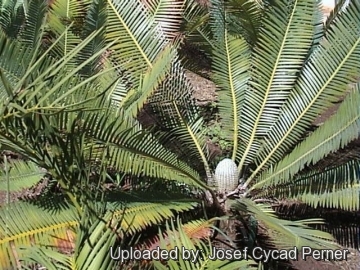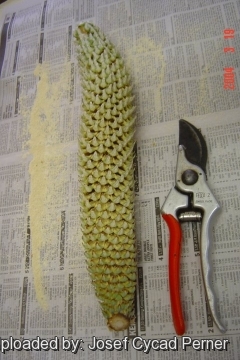
Dioon edule Photo by: Josef Cycad Perner
Dioons are extremely slow growing to our eyes but we must understand that they have been around for over 200 million years (remember these plants were around during the time of dinosaurs). Notice their distinctive character which reflects their antiquity and some very large specimens could possibly be several hundred years old. They truly are unequalled and intriguing living organisms that count the eons of time while we count the seconds. They are beauties.
Origin and Habitat: Eastern part of Mexico (Hidalgo, Querétaro, Nuevo Leon, San Luis, Tamaulipas, Veracruz) where it is widely distributed in the Sierra Madre Oriental. This species is endemic to Mexico. Plants are centered in two areas nl. central Veracruz in an area near to Xalapa and then in an area spanning northern Hidalgo, Querétaro, San Luis Potosí, and southern Tamaulipas states. Dioon eduleSN|11224]]SN|11224]] is known from many localities, with many thousands of adult plants. Some populations have declined substantially, but overall decline is relatively low.
Habitat and ecology: This species grows in areas transitional between tropical deciduous forest and oak woodland, and in harsh, dry conditions in steep hillsides anf cliffs on extremely steep slopes where the soils are skeletal and poor with few nutrients, in limestone, serpentine or in sandy soil, but they can also be found in more hospitable soils and shelter. Interestingly, Dioon eduleSN|11224]]SN|11224]] specifically has the ability to contract its stem underground as it grows — thus maintaining relativity in the amount of trunk exposed. One suggested explanation for this strange (unplant-like) activity is to reduce its exposure to environmental stress and predation —. Also, they may go through prolonged periods of rest, revealed as narrowing in the diameter of the trunk. This species has been affected by habitat destruction and over-collecting for ornamental purposes.
Synonyms:
See all synonyms of Dioon edule
back
Accepted name in llifle Database:Dioon edule Lindl.Edwards's Bot. Reg. 29(Misc.): 59. 1843Synonymy: 26
back
Common Names include:
ENGLISH: Comb-like Leaf, Virgin’s Palm, Chestnut Dioon, Dioon
ITALIAN (Italiano): Dione
SPANISH (Español): Palma de la Virgen, Peine, Palma de Dolores, Palma de Santa Teresita
Description: Dioon eduleSN|24411]]SN|11224]] is a woody dioecious, plant that superficially resemble a palm or a tree fern.
Stem: The trunk is usually unbranched or sparsely branched, palm-like and may reach 4 m of height under optimal conditions (Usually less), 20-50 cm diameter. In the trunk of all cycads growth ring are absent, but, in Dion edule and Dioon spinulosum growth ring are evident, however this growth rings are neither annual nor seasonal and appear only at intervals of 20-30 (or more) years.
Leaves: Produces 15 to 150 leathery, featherlike (pinnate) leaves. They are spirally arranged in a cluster that extend radially at the summit of the stem, they are stiff, upright, light or bright green or blue or blue-green, semi-glossy to dull, 100-200 cm long, flat (not keeled) in section (opposing leaflets inserted at 180° on rachis), with 70-150 leaflets tapering to a sharp point; basal leaflets reducing to spines, petiole spine-free for 5 cm. They resemble futuristic radio antennae and are retained for some number of years.
Leaflets narrowly lanceolate, concolorous, not falcate, inserted at 90° to rachis, not overlapping; margins flat, entire; median leaflets 6-12 cm long, 5-10 mm wide.
Flowers: Male Flowers: Pollen cones ovoid to fusiform, pale brown, 15-40 cm long, 6-10 cm diam. Microsporophyll apex 30 mm long, 20 mm wide. Female cones: Seed cones ovoid, pale grey, 20-35 cm long, 12-20 cm diam. Megasporophyll apex 35 mm long, 25 mm wide.
Fruits: The seed cones entirely resemble those of truly coniferous genus Araucaria or a pineapple in form but the scales are feather-like and soft to the touch. A mature female cone may weigh 1-2 kg and contain up to 200 or more seeds. Eventually the cone unravels to reveal nut sized seeds with a thin leathery skin.
Seeds: Ovoid, cream or white, 25-45 mm long, 20-30 mm wide, they take more than a year to mature.
Remarks: The giant dioon Dioon spinulosumSN|11224]]SN|24411]] is similar but larger in stature and less cold hardy.
Bibliography: Major references and further lectures
1) Chemnick, J. & Gregory, T. 2010. Dioon edule. The IUCN Red List of Threatened Species. Version 2015.2. <www.iucnredlist.org>. Downloaded on 22 August 2015.
2) Boris Lariushin “Cycadaceae Family” Lulu.com
3) V.P. Singh “Gymnosperm (naked seeds plant) : structure and development” Sarup & Sons, 01 January 2006
4) Terrence Walters, Roy Osborne “Cycad Classification: Concepts and Recommendations” CABI, 12 January 2004
5) Norstog, K.J. and Nichols, T.J. “The Biology of the Cycads.” Cornell University Press, Ithaca.1997
6) Whitelock, Loran M., “The Cycads”, Timber press, 2002
7) Haynes J.L, “World List of Cycads: A Historical Review”, IUCN/SSC Cycad Specialist Group, 2012.
8) Jones, D.L. “Cycads of the World.” 2nd edn. Reed, Sydney.2002.
 Male cone in Joe's Cycad Gardens. Photo by: Josef Cycad Perner
Male cone in Joe's Cycad Gardens. Photo by: Josef Cycad Perner Male cone in Joe's Cycad Gardens. Photo by: Josef Cycad Perner
Male cone in Joe's Cycad Gardens. Photo by: Josef Cycad Perner Photo by Cycad International. https://www.facebook.com/Cycads Photo by: Josef Cycad Perner
Photo by Cycad International. https://www.facebook.com/Cycads Photo by: Josef Cycad Perner Photo by Cycad International. https://www.facebook.com/Cycads Photo by: Josef Cycad Perner
Photo by Cycad International. https://www.facebook.com/Cycads Photo by: Josef Cycad Perner Dioon edule seedling from Santa Rita Photo by: Cactus Art
Dioon edule seedling from Santa Rita Photo by: Cactus Art Collecting pollen. Photo by: Josef Cycad Perner
Collecting pollen. Photo by: Josef Cycad Perner Dioon edule Photo by: Cactus Art
Dioon edule Photo by: Cactus Art Dioon edule new fronds. Photo by: Josef Cycad Perner
Dioon edule new fronds. Photo by: Josef Cycad PernerCultivation and Propagation: Dioon edule is a very adaptable plant to just about any soil except muddy, non-draining clay. It is long lived and slow growing and a plant with 30cm of stem can be quite old (20-40 or more years).
Soils: It prefer well drained, gritty soil with plenty of water, especially in dry weather.
Fertilization: Naturally undemanding for nutrients, it responds very well to regular applications of fertilizer. Growth can be greatly improved through the application of fertilizers. Most growers find that a fertilizer having an even NPK (Nitrogen, Phosphorus, Potassium) balance, and supplemental trace elements, provides a good start for cycads.
Exposure: It thrives and grows best in partial shade.
Waterings: In cultivation prefers moist soil with good drainage for optimal growth. But it is eventually very drought resistant.
Hardiness: Mature and established plants have been reported to tolerate temperatures down to -12º C for some days. {Dioon eduleSN|11224]]SN|11224]]}}e is one of the most cold hardy cycads.
Propagation: Virgin's palm may be propagated by seeds or by division and replanting of the attractive offsets or "pups" formed at the base of the oldest plant. They are among the easiest plants to germinate. The seeds are about a large grape size and hard as a rock.
Uses: The Indians of the region of origin have used the pulp of the seed as a source of flour (The young seeds are ground and cooked into tortillas) and also the stem of this plant contains abundance of starch, which may be extracted and used as arrow-root. We know little of the precautions used to prepare them for consumption, but since the skin of the seeds is reportedly carcinogenic we strongly advise the use of gloves when handling the seeds and caution against eating any parts of any cycad! The leaves (fronds) of virgin's palm are used for decoration, especially in religious ceremonies.
Warning: The leaflets of dioon taper to a sharp point. It is well advised to plant virgin's palm away from footpaths and walkways. Wear heavy gloves when handling or working close to the virgin's palm to avoid getting jabbed by the sharp points of the leaflets.
Your Photos

by Valentino Vallicelli

by Cactus Art

by Cactus Art

by Valentino Vallicelli

by Josef Cycad Perner






















